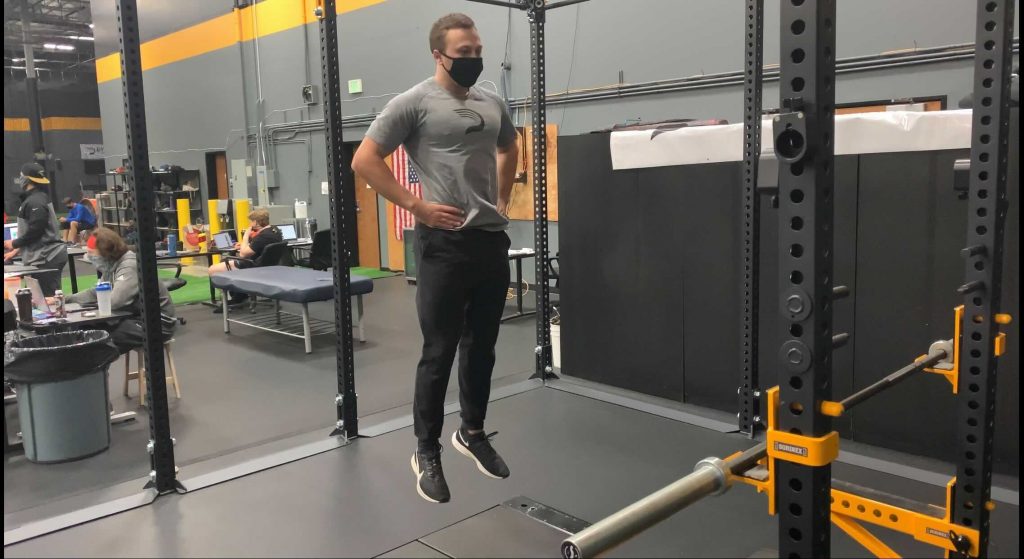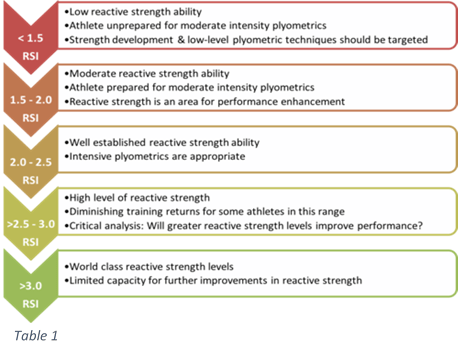What is the 10 to 5 Repeated Hop Test?

If you haven’t read our High Performance assessment summary blog, it is a good place to start.
The repeated hop test is an assessment in which an athlete hops a predetermined number of times—often five or ten—consecutively, with the goal of maximizing the ratio of their flight time to ground contact time.
Flight time divided by ground contact time is referred to as reactive strength index (RSI) and is a measure of an athlete’s ability to quickly produce force under high eccentric load. While we use the hop test mainly to measure reactive strength, there are other metrics that can be useful to look at in some scenarios that fall outside the scope of this article.
We’ll focus on the uses of the repeated hop test here.
Hop Test Protocol
- Calibrate the force plates and then weigh the athlete.
- Cues:
- “Stand still with your hands on your hips.”
- “Jump straight up and down 10 times in a row, trying to jump as high as possible while spending as little time on the ground as possible.”
- Each hop should be performed with minimal hip and knee bend. In other words, each hop should be performed with minimal countermovement between reps. If an athlete is using too large of a countermovement (resulting in too much ground contact time), we will add on an additional cue: “Think like you’re trying to jump rope, but you’re jumping for height. So your legs should remain fairly stiff & straight.”
- Take 20 seconds to rest between trials.
- Repeat for a second and third trial and accept the two best trials for data analysis.
The Reasoning Behind our Procedure
We perform the test using the 10 to 5 method. This is a variation test in which the athlete performs ten jumps, and only the top five jumps are accepted in the test results. The protocol of eliminating the lower scoring reps was put in place because often those jumps produce lower RSI due to deficiencies in posture rather than in the properties that we are trying to measure[1].
Some RSI tests do not remove any scores, but the removal of the lower scoring reps was “deemed reliable for determining RSI for male, female, and pooled male and female cohorts”[2]. As with any test implemented in the assessment process, we need it to meet a high standard of reliability for comparison between trials as we test and retest and compare athletes to their peers.
The test has also shown slim benefits of familiarization after the first rep, with an 11.55% change between trials 1 and 2, and only a maximum between-trial change of 1.25% in trials 2-5[3]. This familiarization benefit is a big part of why we perform two trials of the test. The data gives us confidence that we are getting enough reps to accurately measure RSI without over-fatiguing the athlete. This is also why we perform three trials, ensuring that no data pre-familiarization is accepted.
The RSI metric is also not very sensitive to athlete fatigue. In a 27-week study in which training volume was varied throughout, there were only 3 weeks out of the 27 in which RSI results deviated significantly[4]. This shows that the test is not heavily impacted by the athlete’s fatigue level, which is important for assessment implementation. We want to trust that the data is not skewed by fatigue.
We do the test with hands-on-hips to avoid any deviation between trials or athletes resulting from upper body movements.
Why the Hop Test is Relevant
As stated earlier, RSI is a measure of an athlete’s ability to quickly produce force under high eccentric load; being able to quickly and effectively go through the stretch-shortening cycle (SSC) is a major component for dynamic athletes. Because RSI is dependent on eccentric stimulus to begin the SSC, we do not expect to see strong correlations to concentric-only actions.
This is seen in a study setting with correlations between RSI and athlete acceleration ability being lower than the correlation between RSI and a measure of maximal speed[5]. The study found a significant negative correlation between RSI and flying 10m sprint times (r=-0.62), meaning that RSI was relevant to top-end sprint speed capacity. The study also found that maximal speed sprinting showed lower ground contact times than the acceleration phase of sprints, making the qualities of lower-body stiffness and the ability to quickly harness elastic energy extremely important, both of which contribute to measures of RSI.
The ability to efficiently use the SSC as measured by the hop test transfers to movements that use a quick eccentric load, such as sprinting, bounding, and changing direction. Hopping and sprinting are examples of a quick SSC, and a countermovement jump is an example of a slower SSC. These dynamic movements are more common tasks that make use of the SSC, but we can also see why it may be relevant to more niche sport demands such as a pitcher’s lead leg striking the ground with great force and needing to quickly and efficiently transfer that force up through the body.
Interpreting the Data
When it comes to interpreting the data from an athlete’s hop test, we evaluate their results compared to the levels in Table 1. A healthy athlete who tests with a low RSI lacks the ability to dynamically use high eccentric loads to output high concentric forces, so we will generally include a xpxlyometricxx progression in their next training block to develop those qualities.
Generally, athletes who test below a 2.0 in RSI receive a beginner xpxlyometricxx program with relatively simple movements and those above 2.0 start with an intermediate level progression.
Other variables such as athlete age, health, and training experience also play a role in their xpxlyometricxx program level, and all athletes must complete the intermediate level as a prerequisite to the advanced progression to ensure they have built a system robust enough to benefit from more complicated or stressful movements.
By Daniel Comstock and Connor White
[1] Harper, D., & Hobbs, S. J. (2011). The ten to five repeated jump test. A new test for evaluation of reactive strength. Runshaw College.
[2] Comyns, T. M., Flanagan, E. P., Fleming, S., Fitzgerald, E., & Harper, D. J. (2019). Interday Reliability and Usefulness of a Reactive Strength Index Derived From 2 Maximal Rebound Jump Tests. International Journal of Sports Physiology and Performance, 14(9), 1200-1204. doi:10.1123/ijspp.2018-0829.
[3] Harper, D., & Hobbs, S. J. (2011). The ten to five repeated jump test. A new test for evaluation of reactive strength.
[4] Markwick, W. (2015). Training load quantification in professional Australian basketball and the use of the reactive strength index as a monitoring tool.
[5] Cunningham, D., West, D. J., Owen, N., & Shearer, D. A. (2013). Strength and power predictors of sprinting performance in professional rugby players. The Journal of Sports Medicine and Physical Fitness, 53(2), 1-7.

Comment section